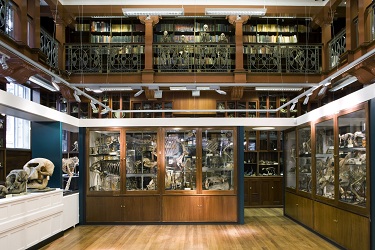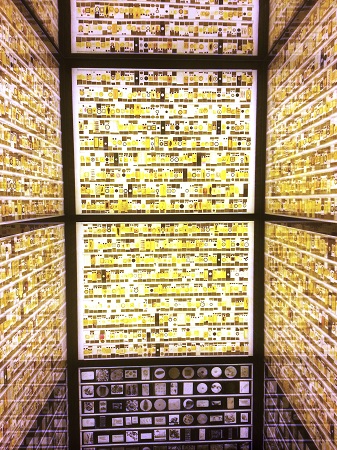The Museum relocated to new premises in March 2011, reopening as an inclusive, experimental space engaging visitors with collections and the natural world through innovative interpretation methods (including “social interpretation”), co-curated research-based exhibitions and high density displays. The ethos of the new Museum is to be a place of experimentation, engagement and inclusion. We aim to increase visitors’ appreciation of the natural world; to broaden their knowledge and understanding of the animals in the collection; to help them explore the depths of the collection, and – crucially – to ensure they enjoy what they see and do. Having to move fast at low cost meant that from the start we conceived the space as experimental; appropriate for a university museum committed to risk-taking and to fostering public dialogue. We have a wonderful historic collection, a beautiful Edwardian panelled room and many original cabinets. We crammed them with incredible specimens, including some of the rarest skeletons on the planet. We also sought to make it demonstrably 21st century in its accessibility and activity; a place where people can engage not just with the collection but with contemporary science. We decided early on that we wanted to use the collection to stimulate discussion and inspiration, and that we wanted to put people right at the heart of the Museum.

What’s unique about the Grant is the incredibly high accessibility of its collections. We have more zoological specimens on display than the UK’s Natural History Museum – all in one room. Perhaps just as importantly, the staff are also on display. All our staff are visible and audible, permanently working in an unenclosed office area inside in the Museum where the only thing that separates us from the gallery is a rhino skeleton. We encourage visitors to ask questions and see what we are doing. In this way visitors can see that we are a working museum constantly using our collections, and ensure that people have access to us at all levels. Through such engagement visitors get a first-hand impression of what museums do.
Our beautiful new Micrarium is a place for tiny things – somewhere to come and explore the microscopic specimens at the Grant Museum. It’s often said that 95% of known animal species are smaller than your thumb, but have you noticed how most museums fill their displays with big animals? To right this wrong we built the Micrarium in January.

We have converted an old office/storeroom into a beautiful back-lit cave displaying some of the tiniest specimens in the collection, on wall-to-wall microscope slides. Museums very rarely display objects like this, and we are experimenting with an aesthetic way of doing so.
At the Museum we see social media as an extremely important way of engaging with our audiences. We pride ourselves on our accessibility and work hard to ensure that audiences can engage with us as easily as possible. All of our staff blog around fifteen times a month and alongside our Twitter feed we are often cited as having a really exciting online presence.
We have introduced ground-breaking iPad-based participative “smart labels” that encourage our visitors to comment on our practice and on the role of science in society. The programme that runs on them – QRator, designed in partnership with academic colleagues at UCL – allows us to ask challenging questions directly related to our displays, such as “What makes an animal British?”, or “Should human and animal remains be treated any differently?” Visitors can respond on the iPads themselves, on their own smart phones by scanning a QR code, or at home on their computers. Some excellent conversations are taking place and the way audiences engage with such technology is being analysed by our university colleagues; the whole Museum has become an experiment.
_UCL,_GMZ_+_Matt_Clayton005.jpg)
The QRator project was highlighted in the New Media Consortium’s 2011 Horizon Report as one of the best examples of emerging technology in museums, and that it is four to five years ahead of the “adoption horizon” for the sector. In May 2012, QRator won the Innovation Award at the Museums & Heritage Awards, the judges noting that it was a technology capable of revolutionising museum interaction with audiences.
Back to top




